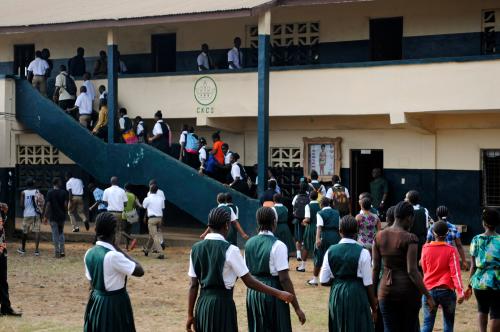Despite an influential view that countries should increase teachers’ wages sufficiently to be able to attract top college graduates to the profession, the available evidence from the U.S. suggests that that’s the wrong advice. Key research studies show that this is wrong for low-income countries as well. If anything, when it comes to teachers in developing countries, there are already too many bucks for the bang.
But first things first.
One example of the view that you need high wages to attract the best teachers is a report by McKinsey and Company, which argues: “Given the real and perceived gaps between teachers’ compensation and that of other careers open to top students, drawing the majority of new teachers from among top-third students would require substantial increases in compensation” (p. 7).
This view is quite widely held. At a recent conference, the former senior director of education at the World Bank, Claudia Costin, argued (much in line with the report) that teachers had to be hired from the top of the college distribution with salaries that were sufficient to draw them to the teaching profession.
While seemingly obvious—who would not want the best teachers for their children?—the advice is misplaced on two fronts. First, it assumes that students who perform well in college—specifically, the top-third graduates—are also better teachers. Second, it assumes that teachers’ wages are currently insufficient to bring in top performing students. But if the attributes that make you a top-third graduate don’t make you a good teacher, countries will spend large amounts trying to lure these graduates away from other lucrative job offers—without much to show for it. And if teachers’ wages in low-income countries are already high enough to attract good teachers, increasing wages further represents a pure transfer to future teachers.
The evidence from the United States is clear (here is a great summary): Much of the variation in teacher effectiveness cannot be tracked back to college performance. In fact, all observed characteristics of teachers typically explain no more than 5 percent of the variation in teacher effectiveness. The one factor that does seem to matter is teaching experience. Teachers improve quite dramatically over the first two years, but further experience does not lead to better teachers. Consequently, much of the “action” in the teacher market has moved to alternate methods of teacher selection—since teacher characteristics are weakly correlated with effectiveness, one big question is how to better design hiring and selection systems so that the best teachers can be identified within two years and retained within schooling systems.
The evidence from low-income countries has been harder to put together, in part because measures of teacher effectiveness require data on student test-scores matched to the teachers who taught them. Typically, the same students need to be observed with multiple teachers, and teachers need to be observed multiple times. Without the kind of administrative data that large testing systems generate, this imposes a significant burden—so significant in fact, that until recently, we had almost no information on the importance of teachers in low-income countries and the links between compensation and effectiveness.
That is now changing, and the jigsaw puzzle is slowly coming together.
Exhibit 1: Two papers from Kenya and India study what happens when children are assigned to teachers on a temporary contract, with wages that are lower than those of permanent teachers. In one study, teachers were allocated randomly to children in the school and in the other, contract teachers were randomized to schools. In both, the learning gains of children assigned to contract teachers were higher than those assigned to permanent teachers.
Note: A third study from Kenya attempts to replicate the contract teacher results with the program administered by nongovernment organizations and by the government. They succeed with NGOs, but not with the government; arguably, it takes longer for these things to work with the government in Kenya.
Exhibit 2: In Indonesia, researchers worked with the government to experimentally evaluate a policy of doubling teachers’ wages. They find zero impact of increased wages on teacher performance. This result suggests that the motivation and effort of existing teachers does not increase with an increase in their salaries.
Exhibit 3: In Ecuador, researchers randomly assigned children to teachers within the school. They were able to replicate most of the teacher effectiveness literature in the U.S., again showing that observed teacher characteristics explained little of the variation in teacher effectiveness. This was despite the fact that they carefully measured what teachers were doing in class through detailed teacher observation modules.
Exhibit 4: In a new paper, Natalie Bau and I try to get at both teacher effectiveness and the link to teachers’ wages in Pakistan. Like in the other studies, we find large differences in the learning of children assigned to different teachers, but little in the way of observable teacher characteristics that are correlated with teacher effectiveness. Again, the first two years of teaching experience matter and one notable result is the importance of teacher test scores in our data.
But here is the surprising finding: A change in the hiring regime that led all new teachers to suddenly be hired under temporary contracts with 35 percent lower wages had zero impact on the quality of new teachers in the public sector—either immediately or four years after the change. In our data, current wages are not linked to teacher effectiveness in the public sector (although they are in the private sector), and these wages appear to be too high. These results largely confirm and extend those from previous studies, but to those who have looked carefully at wage distributions among teachers in the public and private sector in South Asia, they should not be surprising. As Figure 1 shows, these distributions are so different that the lowest paid teachers in the public sector still receive greater compensation than the highest paid teachers in the private sector!
Figure 1: The highest paid teachers in private schools earn significantly less than the lowest paid teachers in public schools

Does all this mean that we should now pay teachers lower wages? Not necessarily. Policy has to take into account a myriad of other factors relative to what researchers study. For instance, teacher compensation is part and parcel of broader civil service compensation, so that the discussion is far broader. Furthermore, higher teacher compensation may have an indirect effect on how much education people choose to get; lowering these returns may have adverse effects on secondary school enrollment. In a country like Pakistan, where teachers are increasingly women and female labor force participation is one of the lowest in the world, this may be more than a “second-order” effect.
But the main message is clear: All the available evidence shows that higher wages do not bring in better teachers or increase the performance of existing teachers. In fact, existing wages are high enough already.
The Brookings Institution is committed to quality, independence, and impact.
We are supported by a diverse array of funders. In line with our values and policies, each Brookings publication represents the sole views of its author(s).








Commentary
Teachers’ salaries: Too many bucks for the bang?
July 21, 2017